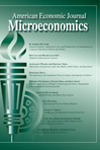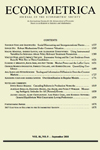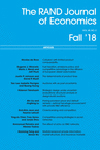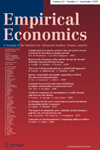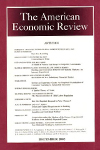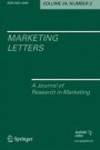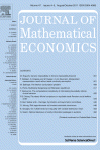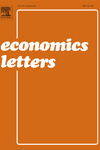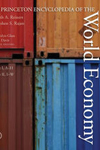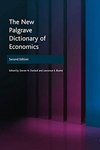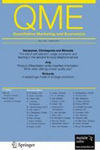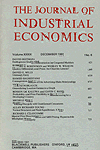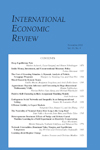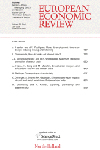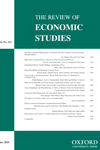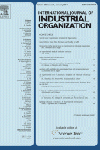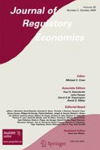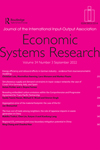Academic Publications
Click on the journal image for a pre-print copy of the published article.
Pass-Through and Tax Incidence in Differentiated Products Markets
The role of demand curvature in determining firm behavior in symmetric oligopolistic product markets is well-understood. We consider the empirically relevant discrete choice differentiated product demand and point to two forces that drive curvature in logit demand: the impact of outside-good spending on the consumer's indirect utility and the heterogeneity in this response across consumers. We use the canonical example of the ready-to-eat cereal market (Nevo, 2000) to contrast elasticity and curvature estimates across several workhorse models. We illustrate that the log-concave Multinomial Logit and Nested Logit demands yield significantly biased curvature estimates. In contrast, a Mixed Logit specification generates a wider range of curvatures, including curvatures larger than one. These results are of immediate relevance to the robust assessment of tax incidence and the pass-through of cost savings, such as from a horizontal merger, in differentiated product markets.
International Journal of Industrial Organization, 90 (102985), September 2023, with Katja Seim and Jeff Thurk.
ScienceDirect
One Markup to Rule them All: Taxation by Liquor Pricing Regulation
Commodity taxation often involves uniform tax rates. We use alcohol laws that tax differentiated spirits with a comprehensive uniform markup to evaluate redistribution generated by such simple tax policy. We document preference heterogeneity among consumers, variation in product demand elasticities, and market power among producers with heterogeneous product portfolios. Relative to more flexible product-level markups recognizing demand heterogeneity and strategic price responses of firms, we find that the uniform markup underprices less elastic spirits, implicitly subsidizing low-income and less educated residents. The uniform markup grants additional market power to small specialized firms whose product positioning benefits from the policy.
American Economic Journal: Microeconomics, 12, 1-41 (lead article), February 2020, with Katja Seim and Jeff Thurk.
AEA and
Web Appendix
Market Power and the Laffer Curve
We study commodity taxation and characterize the Laffer curve, a trade-off between tax rates and revenue, in noncompetitive markets. Pricing in these markets leads to incomplete tax pass-through and agents re-optimize their purchase and pricing decisions in response to any tax change. We use detailed data from Pennsylvania, a state that monopolizes retail sales of alcoholic beverages, to estimate a model of demand for horizontally differentiated products that ties consumers' demographic characteristics to heterogeneous preferences for spirits. We find that under the state's current tax policy, spirits are overpriced. Distillers respond to decreases in the tax rate by increasing wholesale prices, which limits the state's revenue gain to only 13% of the incremental tax revenue predicted under the common assumption of perfect competition. The strategic response of noncompetitive firms to changes in taxation therefore flattens the Laffer curve significantly.Fuel Taxation, Emissions Policy, and Competitive Advantage in the Diffusion of European Diesel Automobiles
Import tariffs have decreased significantly over the past 30 years due to a large number of economic integration agreements. We investigate whether national policies can be an effective replacement for tariffs to protect domestic industry. Our focus is the European automobile market where we show fuel taxes and vehicle emissions policy favored diesel vehicles, a technology popular with European consumers but largely offered only by domestic automakers. We estimate a discrete choice, oligopoly model of horizontally differentiated products using Spanish automobile registration data where we observe engine type. We show European automakers benefited from pro-diesel fuel taxes and a lenient NOx emissions policy to earn significant profits from diesel cars. Had regulators used policies which did not favor diesels, consumers would have shifted consumption towards gasoline-powered imports. We show both policies amounted to significant non-tariff trade policies equivalent to an import tariff between two to three times the official rate.
RAND Journal of Economics, 49, 504-540, Fall 2018, with María J. Moral, and Jeff Thurk.
JSTOR
Consumer Inertia, Choice Dependence and Learning from Experience in a Repeated Decision Problem
Understanding when and how individuals think about real-life problems is a central question in economics. This paper studies the role of inertia (inattention), state dependence and learning. The natural setting is the Kentucky tariff experiment when optional measured tariffs for local telephone calls were introduced. We find that consumers tend to align correctly their choices of tariff and telephone usage levels. Despite low potential savings, mistakes are not permanent as individuals actively engage in tariff switching in order to reduce the monthly cost of telephone services. Ignoring unobservable heterogeneity and the endogeneity of past choices would have reversed these results.
Review of Economics and Statistics, 96, 524-537, July 2014, with Ignacio Palacios-Huerta.
JSTOR
Testing for Complementarity among Countable Strategies
I study whether the pricing strategies of competing duopolists in the early U.S. cellular telephone industry can be considered strategic complements or substitutes. In order to do so, I present a multivariate count data regression model that is suitable to test for the existence of strategic complementarities when firms make use of countable strategies. The estimator, which accommodates the underdispersion that characterizes the data, is shown to have better small sample properties than common estimators based on the Gaussian copula. It also allows for correlations of any sign among counts independently of the dispersion parameters. Results show that in addition to screening consumers, competing firms imitated each other in the number of tariff options offered to their customers.
Empirical Economics, 46, 1521-1544, June 2014.
Springer
Competition and the Use of Foggy Pricing
Firms engage in foggy pricing when the menu of tariff options aims at profiting from consumer mistakes. The analysis of this paper concludes that the transition from monopoly to competition in the early U.S. cellular telephone industry does not foster the use of such deceptive strategies. I offer three possible measures to account for the fogginess of the menu of options offered by cellular carriers. All results are robust to the existence of uncertainty regarding future consumption at the time of choosing a particular tariff option, as well as to consumers' heterogeneity with respect to cellular telephone usage.Sinking, Swimming, or Learning to Swim in Medicare Part D
Under Medicare Part D, senior citizens choose prescription drug insurance offered by numerous private insurers. We examine non-poor enrollees' actions in 2006 and 2007 using panel data. Our sample reduced overspending by $298 on average, with gains by 81% of them. The greatest improvements were by those who overspent most in 2006 and by those who switched plans. Decisions to switch depended on individuals' overspending in 2006 and on individual-specific effects of changes in their current plans. The oldest consumers and those initiating medications for Alzheimer's disease improved by more than average, suggesting that real-world institutions help overcome cognitive limitations.
American Economic Review, 102, 2639-2673, October 2012, with Jonathan D. Ketcham, Claudio Lucarelli, and M. Christopher Roebuck.
AEA (Winner of the 19th Annual National Institute for Health Care Management)
A Roman TARP Program
Emperor Tiberius (A.D. 14-37) personally bailed out banks to overcome usury and the lack of credit following the disastrous lending rules passed by the Roman Senate.
Journal of Political Economy, 120, back cover, June 2012.
JSTOR
Price Discrimination in Service Industries
We survey the existing literature on price discrimination in service industries. In scope, we limit ourselves to models of nonlinear pricing and bundling like those typically applied and analyzed in such industries. We introduce the benchmark approach commonly used in the literature and summarize the existing results on the profitability and welfare effects of price discrimination. We also survey areas of high current research activity. Next, we highlight four areas we feel are the most fruitful avenues for future research. The first is to better understand pricing-structure dependent preferences, for example in the setting of even more varied nonlinear pricing structures or in the context of bundling. The second focuses on the need to identify dynamics in usage decisions. We suggest further exploring consumer learning under complex pricing structures andfind it increasingly necessary to explore optimal nonlinear price schedule in a competitive setting.
Marketing Letters, 23, 423-438, June 2012, with Anja Lambrecht, Katja Seim, Naufel Vilcassim, Amar Cheema, Yuxin Chen, Gregory Crawford, Kartik Hosanagar, Raghuram Iyengar, Oded Koenigsberg, Robin Lee, and Ozge Sahin.
Springer
Competitive Pressure and the Adoption of Complementary Innovations
Liberalization of the European automobile distribution system in 2002 limits the ability of manufacturers to impose vertical restraints, leading to a substantial increase in competitive pressure among dealers. We estimate an equilibrium model of profit maximization to evaluate how dealers change their innovation adoption strategies following the elimination of exclusive territories. Using French data we evaluate the existence of complementarities between the adoption of software applications and the scale of production. Firms view these innovations as substitutes and concentrate their effort in one type of software as they expand their scale of production. Results are robust to the existence of unobserved heterogeneity.
American Economic Review, 102, 1540-1570, June 2012, with Tobias Kretschmer and José C. Pernías.
AEA and
Web Appendix
Convolution and Composition of Totally Positive Random Variables in Economics
This paper studies a class of multidimensional screening models where different type dimensions can be aggregated into a single-dimensional sufficient statistic. The paper applies results of totally positive functions to show that some critical properties of distributions of asymmetric information parameters, such as increasing hazard rate, monotone likelihood ratio, and single-peakedness are preserved under convolution or composition. Under some general conditions, these invariance results also provide a natural ordering of alternative screening mechanisms. I illustrate how these preservation results provide a unifying framework to interpret several contributions in economic models of adverse selection, moral hazard, and voting.
Journal of Mathematical Economics, 47, 479-490, August/October 2011.
ScienceDirect
Testing for Complementarity when Strategies are Dichotomous
We show that it is not possible to extend Arora's (1996) reduced form test for the existence of complementarity to evaluate the relationship between a couple of dichotomous strategies. In general the correlation among residuals of the regressions of different strategies on observable firm and market heterogeneity may respond to the existence of complementarities among these strategies as well as to the correlation among the unobservable returns of each strategy. We show that in the case of dichotomous strategies only the latter case is possible because the existence of complementarities leads to an incoherent simultaneous discrete response model.
Economics Letters, 106, 28-31, January 2010, with José C. Pernías.
ScienceDirect
Competing with Menus of Tariff Options
The nature of numerous strategies of firms is often discrete or countable. This adds difficulty to measuring and testing for the existence of complementarities among several strategies. This paper introduces a generalized multivariate count data model that allows estimating correlations of any sign among the pricing decisions of competing firms in a manner that is robust to the existence of unobserved heterogeneity leading to either over and underdispersion of the distribution of counts. Thus, it is possible to overcome a major challange in testing whether two decisions are strategic complements or substitutes, i.e., dealing with the effect of unobserved heterogeneity. I study how firms actually compete in nonlinear tariffs by analyzing the interrelation between the incumbent and entrant's decisions to offer a given number of tariff options. Results document the existence of complementarity among tariff options regardless of whether they are dominated or not. This result supports the view that the implementation of nonlinear tariffs by means of a menu of self-selecting two-part tariffs has some strategic value in competitive environments.
Journal of the European Economic Association, 7, 188-205, March 2009.
JSTOR
Infant Industry Argument
Infant industry tariff protection works whenever cost reduction due to learning effects are sufficiently strong relative to the discount rate. In addition such a policy needs to be time consistent to avoid future deviations. When using Markov strategies, a time consistent tariff protection policy will eventually open the economy to free trade.
In Kenneth Reinert and Ramkishen Rajan (eds.): The Princeton Encyclopedia of the World Economy, Vol. II, 622-626. Princeton University Press, 2008.
Proquest
Price Discrimination: Theory
Price discrimination comprises a wide variety of practices aimed to extract rents from base of heterogeneous consumers. When consumer types remain private information and only their distribution is known to the monopolist finding the optimal nonlinear tariff involves solving a constrained variational problem that characterizes the optimal markup for each purchase level so that consumers of different types have no incentive to imitate the behavior of others. Fully separating equilibrium is ensured when the distribution of types fulfills the increasing hazard rate property and individual demands can be Unambiguously ranked. Outside this framework, optimal tariffs are difficult to characterize.
In Steven N. Durlauf and Larry E. Blume (eds.): The New Palgrave Dictionary of Economics, 2nd edition. Palgrave Macmillan, 2008.
Springer
The Role of Self Selection, Usage Uncertainty and Learning in the Demand for Local Telephone Service
Telephone services are often characterized by the presence of fixed plans, involving only a fixed monthly fee, as well as measured plans, with both fixed fees and per-unit charges for usage. Consumers are faced with the decisions of which plan to choose and how much to use the phone and these decisions are not, in general, independent. Due to the presence of a time lag between plan choice and usage decisions, consumers are uncertain about usage at the plan-choice stage. We develop a structural discrete/continuous model of plan choice and usage decisions of consumers that accounts for such uncertainty. Prior research has also found that consumers switch less often from fixed plans to measured plans to gain from potential savings than vice versa. Consumer uncertainty regarding their mean usage levels and different rates of learning by consumers in the two plans is a potential explanation for this phenomenon. We extend our discrete/continuous model to account for consumer learning about their mean usage and estimate different rates of learning for the two types of plans. We estimate our model using data from the 1986 Kentucky local telephone tariff experiment. Even in the absence of any price variation over time, we are able to measure the price elasticities both of usage and of choice of plan. Using our parameter estimates, we simulate the effects of the introduction of a metered plan in a market with only a fixed plan and vice versa, on both firm revenues and consumer surplus. We also find that consumers learn very rapidly if they are on the measured plan but learn very slowly when they are on the fixed plan. We investigate an alternative assumption on the nature of the learning process in which only consumers in the measured plan have an opportunity to learn. We find that our empirical results are robust to this change of specification. We conduct counterfactual simulations to simulate enhanced calling plans from the firm and consumer points of view. Additional simulations to measure the value of information in this category are also carried out. We compute the value of both complete information, where the entire uncertainty about future usage is resolved, as well as that of limited information, where the consumer’s uncertainty about mean usage is resolved, but the uncertainty about specific month-to-month usage remains. We find that the value of information is modest. We also find that a large proportion of the value of information is that about the mean usage, with the value of the information about a specific month’s usage being relatively small.
Quantitative Marketing and Economics, 5, 1-34 (lead article), March 2007, with Sridhar Narayanan and Pradeep K. Chintagunta.
Springer
Innovation Complementarity and Scale of Production
We present an econometrically feasible model that uses the information contained in the innovation profile of each firm to test for the existence of complementarity among production and innovation strategies. Our approach is able to distinguish between complementarity and correlation induced by unobserved heterogeneity. We apply the model to analyze the Spanish ceramic tiles industry where the adoption of the single firing furnace in the 1980s facilitated the introduction of new product designs as well as to opening new ways of organizing production. Our econometric results show that there is significant complementarity between product and process innovation. Small firms tend to be more innovative overall.
Journal of Industrial Economics, 54, 1-29 (lead article), March 2006, with José C. Pernías.
JSTOR
The Welfare Performance of Sequential Pricing Mechanisms
Consumers are commonly required to subscribe to particular tariff options before uncertainty regarding their future purchases gets resolved. Since the general comparison of welfare performance of different pricing mechanisms is ambiguous, this paper empirically evaluates the expected welfare associated to standard nonlinear pricing and optional tariffs by using information directly linked to the type of individual consumers. Results shows that tariffs composed of nonlinear options does not necessarily outperforms simpler pricing strategies in terms of expected profits. Furthermore, the evidence suggests that a menu of optional two-part tariffs dominates any other pricing strategy from an expected welfare perspective.
International Economic Review, 46, 1321-1360. November 2005.
JSTOR
Estimating Price-Cost Markups under Nonlinear Pricing Competition
This paper provides a structural interpretation to the estimates of the shape and position of nonlinear tariffs. We focus on the evaluation of price-cost margins, and thus we need to identify marginal cost from an equilibrium model of nonlinear pricing competition. We estimate these price-cost margins using quarterly data from the early U.S. cellular telephone industry between 1984 and 1988. Our results indicate that the margins are increased under duopoly, due to a significant reduction in marginal costs. Moreover, we find that the price-cost margins vary over the consumption levels and that low end users are subject to higher price-cost margins than high-end users. The impact of competition further increases the margins in the low-end user segment, relative to high end-users. In that sense the benefits of competition, which are largely due to increased efficiencies, are passed on relatively more to high-end users. We also show that these findings are robust even if one includes a number of observable market demand and cost variables.
Journal of the European Economic Association, 2, 526-535, April-May 2004, with Lars-Hendrik Röller.
JSTOR
Time-Consistent Protection with Learning by Doing
Can a government induce efficiency gains in his domestic industry by protecting it against foreign competition? Would such trade protection be time-consistent? The present paper builds a dynamic equilibrium model that accounts for learning-by-doing effects that link firms' strategies over time. The model shows that the existence of dynamic economies of scale suffices to overcome the traditional government's lack of commitment of its tariff policy. This paper compares the infinite horizon Markov Perfect Equilibrium of this game with the dynamic equilibrium under commitment as well as the static Nash equilibrium. Equilibrium strategies are derived in closed form by solving a linear--quadratic differential game. Optimal trade policy involves higher tariff levels than in the static setup in order to account for future gains in efficiency. Under reasonable assumptions, the unique stable MPE is characterized by a domestic price and tariff that decrease as experience accumulates, thus supporting the future liberalization of trade as an equilibrium feature of this dynamic game.
European Economic Review, 47, 761-790, (lead article) October 2003.
ScienceDirect
Choosing the Wrong Calling Plan? Ignorance and Learning
It is commonly believed that consumers make frequent mistakes when subscribing to telephone calling plans. The fact that consumers show a strong preference for flat rate options has been frequently interpreted as evidence of irrational behavior. Such a choice is generally thought not to be cost minimizing ex-post. My results, obtained using data from the 1986 Kentucky tariff experiment, contradict these views and provide strong evidence in favor of the rationality of consumers' choices. I find that expectations regarding future consumption play an important role in the choice of calling plan. But more importantly, the evidence shows that there exist important learning effects that induce consumers to switch plans. Switching occurs in order to minimize the magnitude of monthly bills even in the short term and in response to very small differences in cost.
American Economic Review, 93, 297-310, March 2003.
JSTOR
Estimating Demand for Local Telephone Service with Asymmetric Information and Optional Calling Plans
In this paper, I study the theoretical and econometric implications of agents' uncertainty concerning their future consumption when a monopolist offers them either a unique, mandatory nonlinear tariff or a choice in advance from a menu of optional two-part tariffs. Agents' uncertainty is resolved through individual and privately known shocks to their types. In such a situation the principal may screen agents according to their ex ante or ex post type, by offering either a menu of optional tariffs or a standard nonlinear schedule. The theoretical implications of the model are used to evaluate a tariff experiment run by South Central Bell in two cities in Kentucky in 1986. The empirical approach explicitly accounts for the existence of informational asymmetries between local telephone users and the monopolist, leading to different, nested, econometric specifications under symmetric and asymmetric information. The empirical evidence suggests that there exists a significant asymmetry of information between consumers and the monopolist under both tariff regimes. All expected welfare components failed to increase with the introduction of optional tariffs for the estimated value of the parameters.Preserving Log-Concavity under Convolution: Comment
The convolution of two log-concave distribution functions is also log-concave, however if only one of the two convoluting distributions is log-concave, the convolution is not ensured to be log-concave.
Econometrica, 70, 1253-54, May 2002.
JSTOR
Infant-Industry Tariff Protection with Pressure Groups
This paper analyzes the increasing tariff protection in the Spanish iron and steel industry over the first third of the 20th century. Learning effects are explicitly included to model a dynamic game of trade liberalization. The government chooses the tariff level while firms decide how much to produce each period. Firm's production decisions determine their future cost levels. Assuming that learning reduces only fixed costs, the dynamic game may be solved in closed form, so that the optimality and time consistency of the actual policy can be evaluated. Furthermore, the model is used to measure the relative importance of producers and consumers on the government's equilibrium tariff strategy. The model is calibrated for year 1913 and it is shown that the existence of important, unexploited, dynamic economies of scale may have justified high tariff levels at that time. In addition the results also show that the Spanish iron and steel producers behaved more competitively than what is commonly assumed, and that the government's protection policy was not significantly conditioned by steel producers.
International Journal of Industrial Organization, 16, 749-84, November 1998.
ScienceDirect
Screening Consumers through Alternative Pricing Mechanisms
This paper addresses the optimal design of optional nonlinear tariffs. Two particular solutions commonly used in telecommunications and other industries are fully characterized. These optimal outlay schedules illustrate how the tariff design is altered when there exists a time lag between tariff choice and consumption. In this model, consumers' uncertainty is resolved in the interim, between the tariff choice and the usage decision, through changes in their types. The paper studies whether the monopolist may profit from screening consumers according to different information sets, and it shows that expected profits are higher under an ex-post tariff if the variance of the ex-ante type distribution is large enough. The paper also shows that no results regarding social efficiency may be obtained in general. Welfare comparison of optional tariffs will be very sensitive to type distributions, how types enter demand specifications, and the relative variance of the type components.
Journal of Regulatory Economics, 9, 111-32 (lead article), March 1996.
Springer
Aggregation in Input-Output Tables: How to Select the Best Cluster Linkage
In this paper we try to give a solution to the aggregation problem on working with Input–Output tables. First of all we verify the degree of similarity among the production functions of the industries which aggregate in each sector. Secondly, once we have established the aggregation by using different cluster analysis, we set a number of conditions required to choose the proper linkage method that allows us to characterize the process of aggregation (weighted or unweighted) of the input–output table.
Economic Systems Research, 3, 99-109 (lead article), June 1991, with Bernardí Cabrer and Dulce Contreras.
Taylor and Francis
"El Desarrollo de la España Contemporánea" by Gabriel Tortella
Review of an excellent economic history book covering the 19th and most of the 20th centuries of economic development in Spain.
The Journal of Economic History, 55, 707-09, December 1995.
JSTOR

